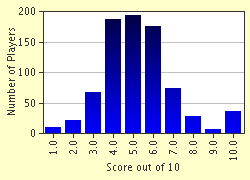Quiz Answer Key and Fun Facts
1. The letter 'e' is the most common letter in the English language.
2. The primary colors of pigment (sometimes called the subtractive primary colors) are red, yellow, and blue.
3. Zero is both an even number and an odd number.
4. There exist three directions such that, by moving in those three directions, it is possible to go anywhere on a two-dimensional surface.
5. In the English language, it is never grammatically correct to start a sentence with "because".
6. The North Pole is the only place on Earth from which it is possible to walk 50 miles south, 50 miles east, and 50 miles north, and end up back where you started.
7. In logic, the converse and inverse of a statement represent different statements, and are not necessarily logically equivalent.
8. In mathematics, there is only one infinity; performing algebraic operations on it does not make it a different quantity.
9. There is actually a painting called "Red Square", consisting of a plain red square.
10. It isn't not untrue that the truth value of the statement "It isn't not untrue that it isn't not false that 2 plus 2 isn't not unequal to 5" doesn't not avoid failing to be false.
Source: Author
lavacamorada
This quiz was reviewed by FunTrivia editor
ozzz2002 before going online.
Any errors found in FunTrivia content are routinely corrected through our feedback system.


